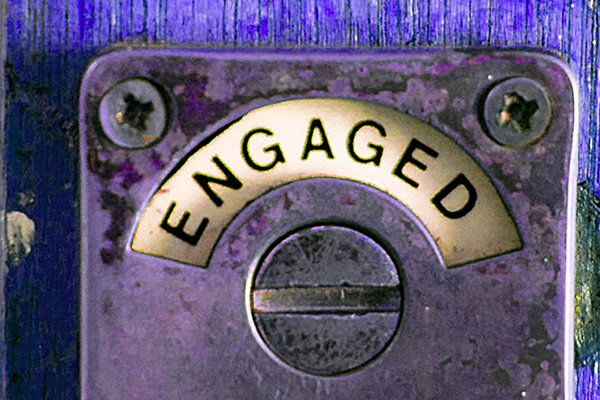Why is it that before we get married, we are ‘engaged’?
Why do many public toilets say the word ‘engaged’ on the outside when they are locked?
The term ‘engaged’ means busy or taken. When we use the term to ‘engage’ with customers, we mean ‘keeping them busy’ or ‘occupying them’.
Obviously, we are not going to keep our prospects and customers busy with us all the time. So, how often do we need to engage? The level of engagement with our customer base really depends on the nature of the business. There is no hard and fast rule but below is a benchmark you can use.
My local supermarket engages with me every week. I have a loyalty card and they engage me with relevant coupons and discounts on the goods that I buy. This is o.k with me because I engage with my supermarket every week, either online or by visiting the store. Therefore, the frequency of engagement does not feel excessive. Simply providing me with coupons and vouchers is very transactional. However, this again is alright. This is because the nature of my interaction with the supermarket is transactional. I buy a few items and I leave.
If my law firm, dealing with my intellectual property, tried to engage with me every week I would go nuts. I use them roughly on a quarterly basis. If they contact me about every six weeks or so that would feel about right. Similarly, if they sent me discount vouchers off my next phone call I would think they had gone mad! My interaction with them is not transactional. It is one of advisor and partner. Therefore, it is better that their engagement reflects that position. Providing me with up to date changes in the market, white papers of trends and videos addressing pertinent issues will be much more appropriate.
The exact opposite is true of my car insurance company, which I contact only once a year. I buy insurance and then hope it does not need to be used. I do not want to hear from my car insurance company once a week or even once every six weeks. Similarly, I am not interested in white papers and videos on trends in the insurance market. In fact, seeing as I only interact with my car insurance company once per year, the most they can probably contact me is about three times in the year. Also, the way they can deliver value will have to be very different from the supermarket or law firm.
Once we understand how often we should engage, and the nature of that engagement, we then need to understand how to measure whether we are engaging effectively. The ultimate measure, of course, will be increased sales.This is measured by identifying with whom we are engaging and who is buying. However, aside from the transaction itself, how is engagement measured?
Engagement should be measured by two factors; ‘interaction’ and ‘influence’.
‘Interaction’ is simple. By using embedded links and tracking content, you will be able to see who opened your email, read an article or how many watched a video. Obviously, if people are not interacting with your communications they are not engaged. Having 5,000 people receiving your newsletter does not mean you have 5,000 people engaged. If it is only opened by ten people, then those ten are engaged and the other 4,990 newsletters are spam!
Measuring ‘influence’ is to measure how much action is taken due to the communications you deliver. Do people buy, sign up to the suggested webinar or click through to other pages on your website? This would show that your content has not only been seen but also has spurred someone into taking another action.
Similarly, ‘influence’ can also be measured by how much a message is shared, retweeted, linked to, etc. This would also demonstrate that people didn’t just see your communications but ‘acted’ on them by sharing, sending to others and spreading your message. By looking at your levels of interaction and influence you can really measure the effectiveness of your engagement with prospects or customers alike.
‘Engagement’ is becoming one of those terms which is now so ubiquitous it is starting to lose its meaning. In my book Sticky Marketing, I stated that businesses now need to move from measuring their marketing by ‘Return On Investment’ to ‘Return On Engagement’. Since then I have become increasingly uneasy with the term as more and more people talk about the ‘need to engage’ customers, without seemingly having any understanding as to what that means. Lets hope we can start to change that now.
Photo credit: slack12 / Foter / CC BY-NC-ND


